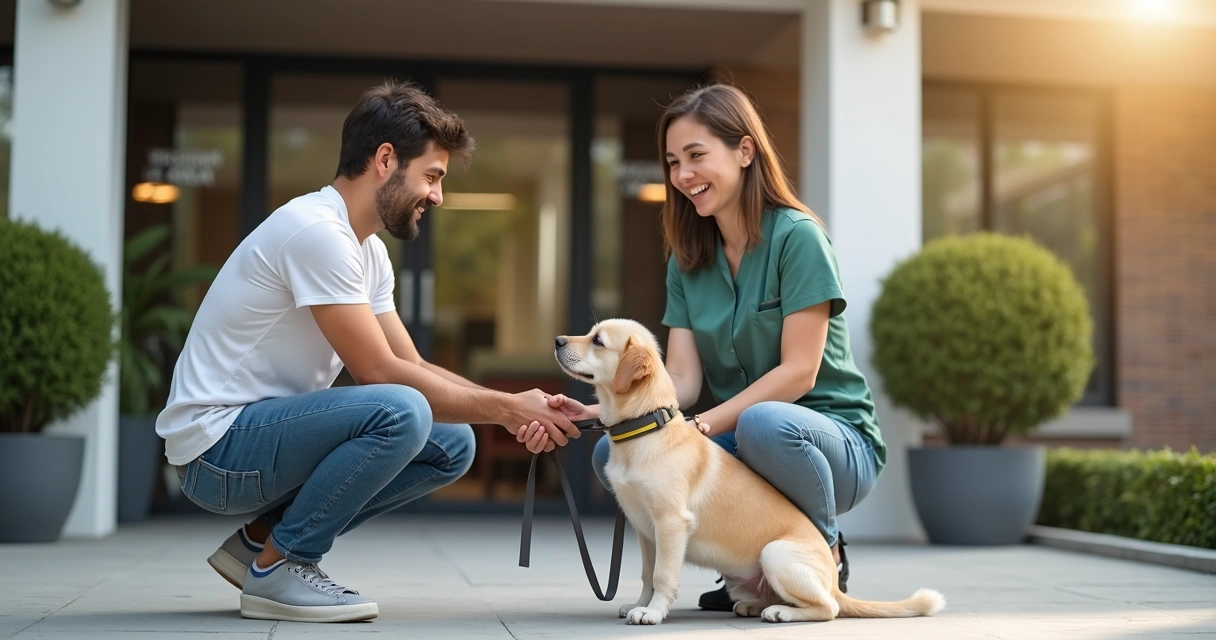If you’re reading this, you probably need to leave your pet in someone else’s care soon. That idea often brings up a jumble of emotions—concern, uncertainty, and maybe even guilt. It’s perfectly normal. After all, pets are family. But choosing between pet boarding at a dedicated facility and in-home boarding isn’t always simple. Sometimes it feels like trying to read your dog or cat’s mind. Still, there are clear differences, and small details can make a big difference for your animal’s comfort and well-being.
Understanding pet boarding
Let’s start with traditional pet boarding. Picture a modern, bright facility like Dogtown in Gloucester, MA—dedicated spaces for both dogs and cats, spacious indoor and outdoor play areas, and trained staff members who seem to know every wag and meow. Pets stay at the facility day and night, interact with other animals, follow structured routines, and get lots of attention. Some might call it a vacation for pets, but, honestly, how much fun a pet has really depends on their personality.

Pet boarding facilities usually offer:
- 24/7 supervision
- Secure indoor and outdoor spaces
- Regular feeding schedules
- Playtime and socialization
- Grooming and enrichment activities (sometimes as add-ons)
At some places, you get perks like:
Structured group play and one-on-one attention—that peace of mind is hard to beat.
At Dogtown’s boarding service, for instance, every pet is supervised by trained staff, with attention to compatibility, temperament, and personal preferences. This minimizes stress and helps animals enjoy their stay, even when their owners are worlds away.
The idea behind in-home boarding
Now, in-home boarding takes a different approach. Instead of bringing your pet to a facility, you arrange for them to stay in someone’s home. Sometimes, you leave them with a friend or a professional pet sitter who boards several animals at a time—just, not in a commercial setting. Your dog or cat might have company, they might not. Either way, it’s supposed to feel more like your pet is getting a sleepover rather than being left behind.
Key features of in-home boarding:
- Home environment, with furniture, smells, and routines similar to what your pet knows
- Fewer animals, meaning less noise and activity
- Possibly more flexibility with feeding, playtime, and cuddles
- Typically, more individual attention
The catch? Every home is different. If your pet likes lots of activity, it could get boring. If your pet doesn’t do well with other animals, you’ll need to clarify if they’ll have the house to themselves.
Pros and cons of pet boarding
Pet boarding facilities keep things organized. Your schedule—and your pet’s—are set from the start. No guessing who is feeding whom. The staff are trained to recognize signs of stress, illness, or anxiety and act quickly.
- Safety: Secure fencing, climate control, regular cleaning, and established protocols for emergencies.
- Routine: Meals and exercise at set times help most pets adjust more easily.
- Socialization: For animals that enjoy meeting new friends, daily group play can be a huge benefit.
- Extra services: Grooming add-ons, dental cleaning, brushing, and training sessions (dog daycare and grooming at Dogtown, for example, are available right at the facility).
- Staff expertise: Trained staff are there to recognize and address subtle signs of discomfort, making adjustments as needed.
Still, not every pet loves boarding. Especially if they’re timid or anxious, the hubbub might feel overwhelming. Sometimes, older animals or those with certain medical needs might feel lost in a busy environment.
Some pets need peace and quiet. Others crave friends.
Pros and cons of in-home boarding
Choosing in-home boarding can feel more personal. Pets relax on couches, meet the family, maybe even sleep in their “host’s” bed. For cats, the chance to stretch out on a sunny windowsill can help ease the transition.
- Personalized attention: With fewer animals to care for, the sitter (or host family) can give more one-on-one time.
- Familiar routines: Less change can reduce stress. Meals, playtime, and even walks may align more with what your pet is used to.
- Home comforts: Some animals simply do better surrounded by household sights and smells.
However, there are concerns. Not every home is pet-proofed. The environment and level of care depend on the sitter. Emergency protocols may not be as robust. If the sitter has other pets or takes on many animals, your dog or cat could get less attention than you hoped.

Really, it’s a bit of a gamble. Sometimes, in-home boarding feels just right. Other times, it’s less reliable than you might want.
Factors to think about before deciding
- Your pet’s personality: A playful extrovert loves the buzz of a boarding facility and group daycare. A shy or older animal might prefer a quieter home or a facility with private suites and more one-on-one care.
- Health needs: If your pet needs medication, injections, or close monitoring, ask how experienced the staff or sitter is. Facilities like Dogtown help with medication, and regular training sessions can even reinforce calm, positive behaviors during stays.
- Age and background: Puppies, kittens, and animals from shelters sometimes adapt better in facilities, where distractions are planned and positive. Elderly pets or those with special backgrounds might need a more home-like setting—though some facilities now offer that too.
- Your own comfort: Sometimes, it’s not just about the animals. If getting daily updates, feedback, or photo check-ins helps you relax on your trip, opt for a provider who makes communication a priority. Dogtown, for example, sends regular feedback during a pet’s day camp or overnight stay (day camp page has more info).
Perhaps a free pre-enrollment assessment, like the one at Dogtown, is the perfect step to understanding what your pet might need. Every animal is different. Choices that suit one may not be right for another.
Making the decision: a few stories
I once left my stubborn little terrier at a facility, worrying she'd spend three days sulking. Instead, she came home tired, happy, and with a new friend that she now meets for walks. On the flip side, my friend's older cat never adjusted to a busy kennel, but curled up contentedly at a sitter’s quiet house.
There isn’t always a “best” answer. There’s just what feels right—for both of you.
What to look for, wherever you choose
Here are a few quick checks to guide your decision:
- Visit the facility or the sitter’s home first, if you can. Trust your gut reaction—does the environment feel safe, clean, and welcoming?
- Review credentials or training, particularly for health or behavioral needs.
- Check policies for emergencies, updates, and what happens if your pet gets sick or uncomfortable.
- Ask about socialization: Do animals mix freely? Are playgroups separated by size or temperament?
- Clarify costs—services like grooming, training, or teeth cleaning may be included, or cost extra (check the grooming page for examples of available add-ons).
Conclusion: what suits your animal?
In the end, the right choice feels a little bit different for every pet and every owner. Traditional pet boarding offers structure, expert care, and a chance for socialization, which works wonders for some animals. In-home boarding feels more personal and homey, helping shy or elderly pets adjust more gently.
Trust your instincts. Trust what you know about your pet.
If you want a mix of structure, safety, and compassion, facilities like Dogtown offer assessments and advice designed just for you and your pet. Ready to discover a care experience made for your animal’s joy? Schedule an assessment with Dogtown and see what your pet’s next adventure could be.
Frequently asked questions
What is pet boarding?
Pet boarding means leaving your dog, cat, or other animal at a dedicated facility while you are away. Facilities like Dogtown offer supervised care, regular routines, comfortable lodgings, playtime, socialization, and sometimes extra services like grooming or dental cleaning. Your pet stays overnight and is looked after by trained staff in a secure, engaging environment.
How does in-home boarding work?
In-home boarding involves leaving your pet at someone else's house, such as a pet sitter or a friend. Your pet joins the daily routine of the host home, sometimes with other pets, or may be the only animal there. The environment is more similar to a regular household, often with more individual attention, home comforts, and flexible schedules for meals and play.
Which option is safer for pets?
Both options can be safe when provided by responsible and trained caregivers. Facilities like Dogtown have secure spaces, regular cleaning, set routines, and trained staff ready for emergencies. In-home boarding depends on the host's experience and environment, and may not always offer the same safeguards. Always check how emergencies, health, and safety are handled wherever you choose.
How much does pet boarding cost?
The price varies depending on the services, location, and length of stay. Boarding at a facility usually includes food, exercise, and basic care, with grooming, training, and medical care available as extras. In-home boarding rates depend on the sitter, number of pets, and special needs. For detailed rates and packages, you can check Dogtown’s offerings to get an idea of typical costs.
Where can I find pet boarding?
You can find pet boarding at local facilities dedicated to animal care, such as Dogtown in Gloucester, MA. Their boarding page gives comprehensive info about the services, pre-enrollment assessments, and packages available for pet owners in the area. Always visit in person or arrange a consultation to see if a provider is a good fit for your pet.





